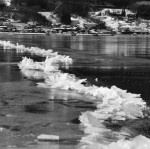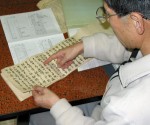Researchers seek new ways to study ecological processes.
Ancient Shinto lore from a shrine on Lake Suwa, Japan, features a temple with a male and female god, who had an argument. The female god decided to build her own temple on the other side of the lake. Every winter after the ice formed on the lake the male god visited her and a serpentine ice ridge (Omiwatari) formed across the ice from the tail of the dragon accompanying him to mark this event.
Each winter since 1452 the Shinto priest held a religious ceremony on the lake to mark the event and recorded the date. This date was also used to judge whether the rice crop would be good in the following season. The ceremony continues to this day.
The Shinto priest’s annual record of freezing and other ice events provides the oldest known annual time series of ice phenology. "Long-term annual observations that stretch back over the centuries are rare," says John Magnuson, a North Temperate Lakes (NTL) LTER investigator who heard this story during a visit to the Shrine in November 2005.
With Japanese colleagues, Magnuson visited a Shinto Shrine to see the original records and talk to the priest about them. One concern was whether the calendar correction at the end of the Edo period in the late 1800s had been made. "Preliminary examination of the time series suggest that the ice-on dates, while highly variable from year to year, had a weak trend from 1452 until the early to mid 1800s, while later in the series from 1897 to 1993 the rate of change had increased markedly to 20 days later per 100 years." Magnuson also notes that the number of winters that the lake did not freeze has increased in recent years.
"The Lake Suwa ice records remind us that some of our longest time series based on direct human observation are from non-scientific observers," Magnuson says. "The longer of these records will help sort out rates of change before and after the period of rapid warming that is now occurring."
Efforts to decipher the story of a landscape often reveal more questions than answers and some LTER ecologists are consulting alternative sources for knowledge. "While TEK often implies Euro-Americans working with non-western or native populations of one kind or another, it is probably more appropriate to think of it as the knowledge held by local populations and/or that which is not immediately attributable to formalized education," says Ted Gragson, Coweeta LTER investigator.
Most importantly, Gragson says, TEK opens up the possibility of incorporating all available human knowledge within the research. Long recognized as a valuable companion to empirical research in fields such as pharmacology, botany (ethnobotany), and agriculture, the use of alternative sources for knowledge is gaining ground in LTER research. For most readers, the literary works of Henry David Thoreau provide pleasant bedside reading. For David Foster, a Harvard Forest LTER researcher, Thoreau’s journals serve as a primary research source for his studies of landscape change in New England’s forests. Notably, Foster was struck by how the forested landscape he observed varied so greatly from the agricultural landscape Thoreau described.
Foster uses Thoreau’s journals to depict the historical practices that shaped the New England landscape in order to interpret their modern ecology and propose approaches to conservation of the forests and farmland. For example, Thoreau noted that "the general aspect of fire is beneficial" -- thinking that took more than a century to be accepted in modern management practice. In his 1999 book, Thoreau’s country: journey through a transformed landscape (Harvard University Press), Foster attributes a great deal of his understanding of the current New England landscape to Thoreau’s historic accounts and notes that ignorance of history limits our understanding of current landscapes, such as how livestock grazing affects a forest.
Arctic LTER investigator Gus Shaver agrees. He cites the work of Roosevelt Paneak, an Inupiat from Anaktuvuk Pass (the nearest town to Toolik Lake, about 70 miles away; it is the only inland Inupiat village) as an excellent example of the use of indigenous knowledge. While working for the Toolik Logistics office at the University of Alaska in Fairbanks, Paneak, who died recently, developed an Inupiat dictionary of place, plant, and animal names from the Toolik region that has proved invaluable to researchers. Shaver adds that Paneak’s father, Simon, was also well known in the history of the Naval Arctic Research Laboratory at Barrow as a guide to scientific parties and an endless source of local knowledge and practical advice.
Many ecologists are learning that traditional knowledge can provide valuable insights that complement and support research findings -- a fact long understood by agricultural researchers. "Agriculture practice and research are practically the same," says Dick Harwood, chief LTER agronomist at the Kellogg Biological Station (KBS) LTER. On a field trip to Indonesia in the 1970s, Harwood and his students encountered a traditional Indonesian farmer dressed in simple garb and barefeet, standing in his small but highly intercropped field. "He was not literate," Harwood recalls, "but he described to us in great detail his intercrop design based on trophic levels of solar intensity within the crop canopy over time." That information led to research by several students to verify the details.
In a 7-year-long "Innovative Farmers of Huron County" project, Harwood’s team measured the effects of the farmer’s innovative tillage practices on carbon and nitrogen processes, and to water infiltration, other soil parameters, and productivity. The study combined farmer-designed changes with LTER science, and some of the practices became an integral part of the LTER design. Although the team co-authored a publication based on the findings with the farmers, Harwood observes that "Farmer understanding and integration capacities are not really well captured by anyone."
At NTL, a small team of scientists and managers used a framework developed by the United Nations Millennium Ecosystem Assessment to study the dynamics of a region in transition, focusing on water quality and fish populations. The analysis involved data collection, analysis, and synthesis as well as discussion with various experts familiar with different areas of northern Wisconsin. "All the scenarios included input from Native Americans, as well as other groups in the Northern Highlands Lake District," says Steve Carpenter. "TEK is a terrific opportunity for interdisciplinary research. The principal barrier is lack of funding for research that integrates TEK with scientific ecological knowledge."
Are there parallel lines that can be drawn between traditional knowledge and modern ecological science? "A ‘long view’ is built into many native cultural practices," Carpenter observes, "It is good to have a balance, so it seems to me that we ought to be looking for cross-calibration of traditional knowledge and technological knowledge."
Roosevelt Paneak’s dictionary and map project are available at the Toolik Field Station web site (toolik.alaska.edu/). A Simon Paneak Museum in Anaktuvuk Pass has more information on Simon and his links to research in northern Alaska in the 1940s-1970s (www.north-slope.org/nsb/55.htm).


 Enlarge this image
Enlarge this image
